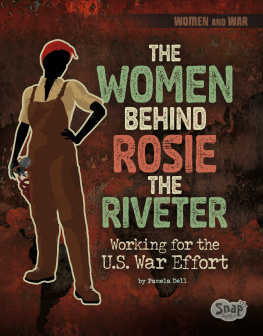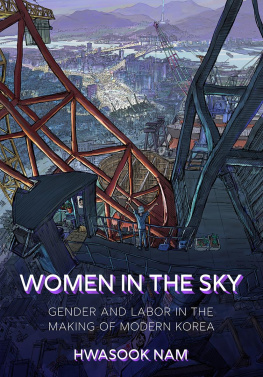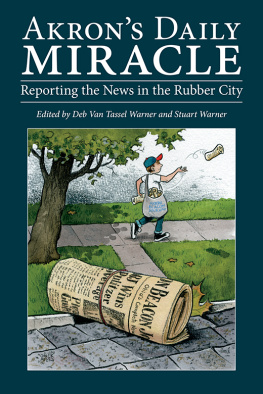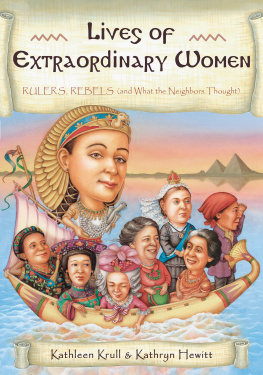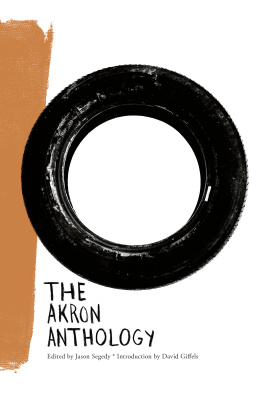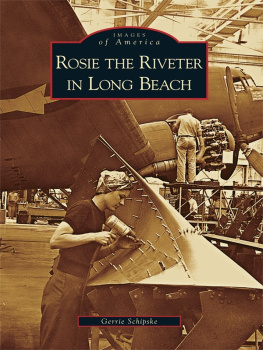2000 by The Kent State University Press, Kent, Ohio 44242
ALL RIGHTS RESERVED
Library of Congress Catalog Card Number 00-035219
ISBN 0-87338-667-1
Manufactured in the United States of America
07 06 05 04 03 02 01 00 5 4 3 2 1
Frontispiece: An unidentified woman at BFG works assembling a life vest.
B. F. Goodrich Collection.
Library of Congress Cataloging-in-Publication Data
Endres, Kathleen L.
Rosie the Rubber Worker : women workers in Akrons rubber factories during
World War II / Kathleen L. Endres.
p. cm.
Includes bibliographical references and index.
ISBN 0-87338-667-1 (cloth : alk. paper)
1. Women rubber industry workersOhioAkronHistory. 2. Women rubber industry workersOhioAkronInterviews. 3. WomenEmploymentOhioAkronHistory. 4. World War, 1939-1945 x WomenOhioAkronHistory.
I. Title.
HD6073.R9 U623 2000
331.4'8783'097713609044dc21 00-035219
British Library Cataloging-in-Publication data are available.
Introducing
Rosie
Rosie the Riveter was a familiar image during World War II, an affable, attractive, young miss who went to work in a factory for patriotic reasons and made the products America needed to wage war. She left the trappings of femininity at homethe stockings, the pumps, the frills. She donned the clothes she needed to get the job donecomfortable shoes, trousers, and work shirt. Her hair was neatly tucked beneath a handkerchief. Rosie always seemed to have the right attitude, as the frequently cited motto, We can do it! attested. But underneath the work clothes and bandanna lurked a woman who looked forward to returning to the kitchen and taking care of her husband and children.
Rosie the Riveter was an image created by the government and industry to help recruit women into the factories during World War II. The historian Maureen Honey outlined the many groups involved with creating Rosie, the image. The War Advertising Council, which represented many leaders of the advertising industry, was among the first groups formed. The council was involved in many campaigns, but its Women in the War program of 1944 is the most famous. In that campaign, the council asked advertisers to address the theme of women production workers and even suggested the most appropriate appeals.
The Office of War Informations Bureau of Campaigns contacted the news, motion picture, graphics, magazine, and radio bureaus to mount a concerted effort. Some of the bureaus sent out story ideas, provided background facts, and helped arrange news tours. The campaign was not just limited to the print media. The new women industrial workers also became radio personalities.
Rubber companiesand their corporate aircraft affiliatesused their women workers to reinforce the Rosie image in a variety of advertisements, posters, news campaigns, and radio broadcasts. These campaigns applauded the role of women workers in rubber production and their commitment to the war effort.
Posters were either issued by the rubber companies or reproduced in the company newspapers. B.F.Goodrich (BFG), for example, reproduced one poster in its War Production News in which a woman was quoted as saying, Ive got a date with VICTORY! So Ill stick to my own little job until the big job is done! The caption read: This lass above seems to know that a few pleasures may have to be given up for the duration of the war, for it is a hard war and she needed to win it. She knows that she must replace a man who has joined Uncle Sams fighting forces. And she knows that even if she should get married during the present manpower crisis, she should stay with the job if at all possible until victory. The companys newspaper also reproduced at least one poster from the This is My war! series. It showed women making pontoons, one product that many female rubber workers made in Akron during World War II.
Not every poster gave such a clear message. In its poster congratulating the workers who made the life raft that saved Captain Eddie Rickenbacker, Goodyear pictured only male workers, even though women workers were heavily involved in life-raft production. Under the headline, Our work sure means something when it saves Rickenbacker and his companions, two workersa woman, Flossie Anson, and a man, E. K. Brownwere quoted: Were builders in the life raft department at Goodyear where the life rafts that saved Captain Rickenbacker and his crew mates were built. Their rescue certainly gave all of our life raft builders a big thrill; made us feel we really were in there pitching in this mans war. Rickenbacker was rescued after being missing at sea for five weeks aboard one of Goodyears life rafts. The workers quoted in that ad continued: Guess thats pretty good proof that when we cement a seam [typically a womans job] we do it for keeps. Now weve a picture of Rick and his raft hanging in the shop. Its a reminder that were helping save the lives of our boys out there. It makes our whole crew feel mighty proud of their work and its importance.
Women were also featured in rubber company advertising. BFG, introduced Mrs. Sherlock Holmes, whose job was to inspect seals. This trained woman inspector threw out the seals that might endanger the lives of the servicemen aboard airplanes. Highlighting the competent woman inspectors was a favorite theme in BFGS wartime advertising. In War job: watching the glowing tubes, BFG proclaimed: So women who are trained tubing experts are busy watching, foot by foot, the many miles of extra tubing needed now to meet war needs. Its a rubber improvement that will help save lives of soldiers or civiliansin peace as well as war time.
Another communication form, which had a much longer life, was the brochure and booklet produced either by the rubber company itself or by its trade organization, the Rubber Manufacturers Association. The Rubber Industry and the War showed women hastening victory by working in factories. All Out for Victory at Firestone showed many women workers, some working with men. But none could compare with the powerful message of Seaman Elgin Staples and his mother, Vera Mueller, who worked in the companys Life Belt Division. A Firestone life belt had saved the sailors life when his ship was sunk in the South Pacific.
Newspapers, magazines, and wire services sent reporters and editors to tour the rubber plants and interview the women workers. In 1943, Goodyear Aircraft was on the itinerary for the Aviation Writers Tour; in 1942, a Camera Caravan visited Firestone. A Philadelphia Inquirer reporter wrote about the women who made barrage balloons; Nations Business showed how women were taking over mens jobs as tire builders.
Women were prominently featured when celebrities came to the rubber factories. After vocalist and band leader Xavier Cugat visited Firestone, the photo in the companys newspaper pictured Cugat with Harvey Firestone, son of the founder, and a woman factory worker, Mrs. Robert Mikesell. War heroes also reinforced the image of Rosie by meeting with the women workers and thanking them for their work. Seaman Basil Dominic Izzi, survivor of eighty-three days on board a raft in the Atlantic, told the womensix of whom were picturedto keep up the good work. One of these rafts may save your father, your husband or your brother, he assured the women at BFG.


